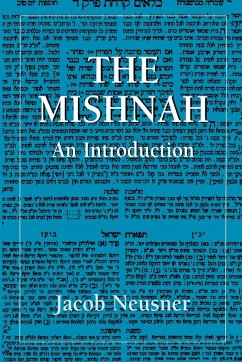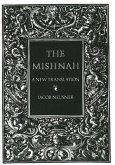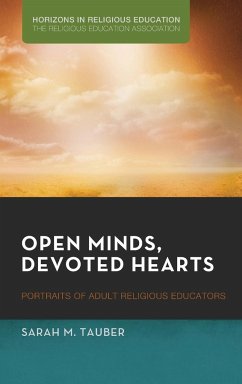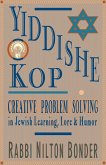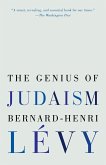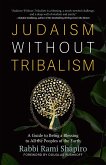- Broschiertes Buch
- Merkliste
- Auf die Merkliste
- Bewerten Bewerten
- Teilen
- Produkt teilen
- Produkterinnerung
- Produkterinnerung
To learn more about Rowman & Littlefield titles please visit us at www.rowmanlittlefield.com.
Andere Kunden interessierten sich auch für
![The Mishnah The Mishnah]() Jacob NeusnerThe Mishnah99,99 €
Jacob NeusnerThe Mishnah99,99 €![Open Minds, Devoted Hearts Open Minds, Devoted Hearts]() Sarah TauberOpen Minds, Devoted Hearts35,99 €
Sarah TauberOpen Minds, Devoted Hearts35,99 €![The Kabbalistic Tradition: An Anthology of Jewish Mysticism The Kabbalistic Tradition: An Anthology of Jewish Mysticism]() Alan UntermanThe Kabbalistic Tradition: An Anthology of Jewish Mysticism16,99 €
Alan UntermanThe Kabbalistic Tradition: An Anthology of Jewish Mysticism16,99 €![Yiddishe Kop Yiddishe Kop]() Rabbi Nilton BonderYiddishe Kop16,99 €
Rabbi Nilton BonderYiddishe Kop16,99 €![An Introduction to the Study of the Kabalah An Introduction to the Study of the Kabalah]() William Wynn WestcottAn Introduction to the Study of the Kabalah21,99 €
William Wynn WestcottAn Introduction to the Study of the Kabalah21,99 €![The Genius of Judaism The Genius of Judaism]() Bernard-Henri LevyThe Genius of Judaism15,99 €
Bernard-Henri LevyThe Genius of Judaism15,99 €![Judaism Without Tribalism Judaism Without Tribalism]() Rabbi Rami ShapiroJudaism Without Tribalism15,99 €
Rabbi Rami ShapiroJudaism Without Tribalism15,99 €-
-
-
To learn more about Rowman & Littlefield titles please visit us at www.rowmanlittlefield.com.
Hinweis: Dieser Artikel kann nur an eine deutsche Lieferadresse ausgeliefert werden.
Hinweis: Dieser Artikel kann nur an eine deutsche Lieferadresse ausgeliefert werden.
Produktdetails
- Produktdetails
- Verlag: Jason Aronson Publishers
- Seitenzahl: 256
- Erscheinungstermin: 1. Oktober 1994
- Englisch
- Abmessung: 229mm x 152mm x 15mm
- Gewicht: 370g
- ISBN-13: 9781568213583
- ISBN-10: 1568213581
- Artikelnr.: 21281355
- Herstellerkennzeichnung
- Libri GmbH
- Europaallee 1
- 36244 Bad Hersfeld
- gpsr@libri.de
- Verlag: Jason Aronson Publishers
- Seitenzahl: 256
- Erscheinungstermin: 1. Oktober 1994
- Englisch
- Abmessung: 229mm x 152mm x 15mm
- Gewicht: 370g
- ISBN-13: 9781568213583
- ISBN-10: 1568213581
- Artikelnr.: 21281355
- Herstellerkennzeichnung
- Libri GmbH
- Europaallee 1
- 36244 Bad Hersfeld
- gpsr@libri.de
Jacob Neusner is Research Professor of Religion and Theology at Bard College and Senior Fellow of the Institute of Advanced Theology at Bard. He has published more than 900 books and unnumbered articles, both scholarly and academic and popular and journalistic, and is the most published humanities scholar in the world. He has been awarded nine honorary degrees, including seven US and European honorary doctorates. He received his AB from Harvard College in 1953, his PhD from Columbia University and Union Theological Seminary in 1961, and rabbinical ordination and the degree of Master of Hebrew Letters from the Jewish Theological Seminary of America in 1960. Neusner is editor of the 'Encyclopedia of Judaism' (Brill, 1999. I-III) and its Supplements; Chair of the Editorial Board of 'The Review of Rabbinic Judaism,' and Editor in Chief of 'The Brill Reference Library of Judaism', both published by E. J. Brill, Leiden, The Netherlands. He is editor of 'Studies in Judaism', University Press of America. Neusner resides with his wife in Rhinebeck, New York. They have a daughter, three sons and three daughters-in-law, six granddaughters and two grandsons.
Table of Contents Preface ix Acknowledgements and Permissions xiii 1. The
Mishnah as Literature 1 Identifying the Mishnah 1 Mishnah Tractate Berakhot
1:1 2 Mishnah Tractate Uqsin 3:11 2 Using the Evidence in Hand 6 The
Contents and Organization of the Mishnah 10 An Outline of the Topical
Program of the Mishnah 13 The Rhetoric of the Mishnah: Patterning Language
17 The Logic of the Mishnah: Proving Propositions 26 The Meaning of the
Mishnah's Rhetoric and Logic 34 The Purpose of the Mishnah: Law Code or
Schoolbook? 37 2. The Mishnah as Religion 40 Defining a Religion and a
Judaism 40 The Mishnah's Judaism before 70 C.E. 42 The Mishnah's Judaism
after the Destruction of the Temple: 70-132 C.E. 45 The Mishnah after 135
C.E.: The System Seen Whole 51 The Judaism of the Mishnah 53 3. The
Mishnah's Social Vision: Means of Production, Market, Wealth 61 The
Building Block of Society in the Mishnah's Social Vision 61 The Household:
Baba Batra Chapter 3 64 The Market: Baba Mesia Chapter 4 79 Wealth: Baba
Mesia Chapter 5 97 The Steady-State Economy in a Static Social World 118 4.
The Mishnah's Social Vision: Woman and Caste 121 Women in the Household 121
Women: Yebamot Chapter 10 123 Case Structure: Qiddushin Chapter 4 131 The
Social Vision of the Mishnah 140 5. The Mishnah's Theological and
Philosophical Vision 149 History and the Laws of History: Rosh Hashanah
Chapter 4, Taanit Chapter 4, Zebahim Chapter 14, Sotah Chapter 9 149 Israel
and God, Partners in the Land: Maaserot Chapter 1 172 Intention: Makhshirin
Chapter 4 181 Humanity in Crisis: What Can Israel Do? 198 6. The Mishnah
and the Torah: The Impact of the Mishnah on the Formation of Judaism 200
The Problem of the Mishnah 200 Tractate Avot Chapter 1 206 The Mishnah and
the Torah: The Theory of Tractate Avot 211 The Yerushalmi Talmud's Theory
of the Mishnah 214 The Mishnah and the Judaism of the Dual Torah 220 The
Relevance of the Mishnah to Judaism in the Twenty-First Century 227
Structure of the Mishnah 230 Index 231
Mishnah as Literature 1 Identifying the Mishnah 1 Mishnah Tractate Berakhot
1:1 2 Mishnah Tractate Uqsin 3:11 2 Using the Evidence in Hand 6 The
Contents and Organization of the Mishnah 10 An Outline of the Topical
Program of the Mishnah 13 The Rhetoric of the Mishnah: Patterning Language
17 The Logic of the Mishnah: Proving Propositions 26 The Meaning of the
Mishnah's Rhetoric and Logic 34 The Purpose of the Mishnah: Law Code or
Schoolbook? 37 2. The Mishnah as Religion 40 Defining a Religion and a
Judaism 40 The Mishnah's Judaism before 70 C.E. 42 The Mishnah's Judaism
after the Destruction of the Temple: 70-132 C.E. 45 The Mishnah after 135
C.E.: The System Seen Whole 51 The Judaism of the Mishnah 53 3. The
Mishnah's Social Vision: Means of Production, Market, Wealth 61 The
Building Block of Society in the Mishnah's Social Vision 61 The Household:
Baba Batra Chapter 3 64 The Market: Baba Mesia Chapter 4 79 Wealth: Baba
Mesia Chapter 5 97 The Steady-State Economy in a Static Social World 118 4.
The Mishnah's Social Vision: Woman and Caste 121 Women in the Household 121
Women: Yebamot Chapter 10 123 Case Structure: Qiddushin Chapter 4 131 The
Social Vision of the Mishnah 140 5. The Mishnah's Theological and
Philosophical Vision 149 History and the Laws of History: Rosh Hashanah
Chapter 4, Taanit Chapter 4, Zebahim Chapter 14, Sotah Chapter 9 149 Israel
and God, Partners in the Land: Maaserot Chapter 1 172 Intention: Makhshirin
Chapter 4 181 Humanity in Crisis: What Can Israel Do? 198 6. The Mishnah
and the Torah: The Impact of the Mishnah on the Formation of Judaism 200
The Problem of the Mishnah 200 Tractate Avot Chapter 1 206 The Mishnah and
the Torah: The Theory of Tractate Avot 211 The Yerushalmi Talmud's Theory
of the Mishnah 214 The Mishnah and the Judaism of the Dual Torah 220 The
Relevance of the Mishnah to Judaism in the Twenty-First Century 227
Structure of the Mishnah 230 Index 231
Table of Contents Preface ix Acknowledgements and Permissions xiii 1. The
Mishnah as Literature 1 Identifying the Mishnah 1 Mishnah Tractate Berakhot
1:1 2 Mishnah Tractate Uqsin 3:11 2 Using the Evidence in Hand 6 The
Contents and Organization of the Mishnah 10 An Outline of the Topical
Program of the Mishnah 13 The Rhetoric of the Mishnah: Patterning Language
17 The Logic of the Mishnah: Proving Propositions 26 The Meaning of the
Mishnah's Rhetoric and Logic 34 The Purpose of the Mishnah: Law Code or
Schoolbook? 37 2. The Mishnah as Religion 40 Defining a Religion and a
Judaism 40 The Mishnah's Judaism before 70 C.E. 42 The Mishnah's Judaism
after the Destruction of the Temple: 70-132 C.E. 45 The Mishnah after 135
C.E.: The System Seen Whole 51 The Judaism of the Mishnah 53 3. The
Mishnah's Social Vision: Means of Production, Market, Wealth 61 The
Building Block of Society in the Mishnah's Social Vision 61 The Household:
Baba Batra Chapter 3 64 The Market: Baba Mesia Chapter 4 79 Wealth: Baba
Mesia Chapter 5 97 The Steady-State Economy in a Static Social World 118 4.
The Mishnah's Social Vision: Woman and Caste 121 Women in the Household 121
Women: Yebamot Chapter 10 123 Case Structure: Qiddushin Chapter 4 131 The
Social Vision of the Mishnah 140 5. The Mishnah's Theological and
Philosophical Vision 149 History and the Laws of History: Rosh Hashanah
Chapter 4, Taanit Chapter 4, Zebahim Chapter 14, Sotah Chapter 9 149 Israel
and God, Partners in the Land: Maaserot Chapter 1 172 Intention: Makhshirin
Chapter 4 181 Humanity in Crisis: What Can Israel Do? 198 6. The Mishnah
and the Torah: The Impact of the Mishnah on the Formation of Judaism 200
The Problem of the Mishnah 200 Tractate Avot Chapter 1 206 The Mishnah and
the Torah: The Theory of Tractate Avot 211 The Yerushalmi Talmud's Theory
of the Mishnah 214 The Mishnah and the Judaism of the Dual Torah 220 The
Relevance of the Mishnah to Judaism in the Twenty-First Century 227
Structure of the Mishnah 230 Index 231
Mishnah as Literature 1 Identifying the Mishnah 1 Mishnah Tractate Berakhot
1:1 2 Mishnah Tractate Uqsin 3:11 2 Using the Evidence in Hand 6 The
Contents and Organization of the Mishnah 10 An Outline of the Topical
Program of the Mishnah 13 The Rhetoric of the Mishnah: Patterning Language
17 The Logic of the Mishnah: Proving Propositions 26 The Meaning of the
Mishnah's Rhetoric and Logic 34 The Purpose of the Mishnah: Law Code or
Schoolbook? 37 2. The Mishnah as Religion 40 Defining a Religion and a
Judaism 40 The Mishnah's Judaism before 70 C.E. 42 The Mishnah's Judaism
after the Destruction of the Temple: 70-132 C.E. 45 The Mishnah after 135
C.E.: The System Seen Whole 51 The Judaism of the Mishnah 53 3. The
Mishnah's Social Vision: Means of Production, Market, Wealth 61 The
Building Block of Society in the Mishnah's Social Vision 61 The Household:
Baba Batra Chapter 3 64 The Market: Baba Mesia Chapter 4 79 Wealth: Baba
Mesia Chapter 5 97 The Steady-State Economy in a Static Social World 118 4.
The Mishnah's Social Vision: Woman and Caste 121 Women in the Household 121
Women: Yebamot Chapter 10 123 Case Structure: Qiddushin Chapter 4 131 The
Social Vision of the Mishnah 140 5. The Mishnah's Theological and
Philosophical Vision 149 History and the Laws of History: Rosh Hashanah
Chapter 4, Taanit Chapter 4, Zebahim Chapter 14, Sotah Chapter 9 149 Israel
and God, Partners in the Land: Maaserot Chapter 1 172 Intention: Makhshirin
Chapter 4 181 Humanity in Crisis: What Can Israel Do? 198 6. The Mishnah
and the Torah: The Impact of the Mishnah on the Formation of Judaism 200
The Problem of the Mishnah 200 Tractate Avot Chapter 1 206 The Mishnah and
the Torah: The Theory of Tractate Avot 211 The Yerushalmi Talmud's Theory
of the Mishnah 214 The Mishnah and the Judaism of the Dual Torah 220 The
Relevance of the Mishnah to Judaism in the Twenty-First Century 227
Structure of the Mishnah 230 Index 231

